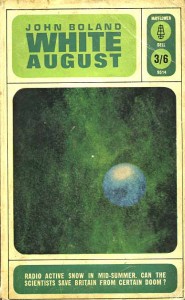Book Review: White August by John Boland
It is one of the hottest Julys on record in Worchestershire. In a time before air conditioning became common in Britain, the people are roasting in the summer heat. So they are more bemused than frightened when it suddenly begins snowing. English weather, isn’t it funny?
Except that it doesn’t stop snowing. For days. As the temperature starts to drop, it becomes all too clear that this is not a natural phenomenon. And as the snow starts to pile up, it is noticed that it’s also radioactive. Britain is under attack by an unseen, unannounced foe with an inexplicable weapon; can science find an answer before it’s too late?
This 1955 novel is a quick read, positing a science fiction device that causes a massive environmental disaster. (J.G. Ballard would later work in the same vein to better effect.) The author works out the details of what a steady fall of snow for weeks on end would have on the infrastructure and society of 1950s Britain.
The government officials depicted in the story are remarkably competent and sensible for the disaster novel subgenre; even the American general is calm and reasonable. The memory of the Blitz is resonant in this story, as people try to muddle through as best they can (though late in the novel, the commoners start going feral.)
The main hero of the story is William Barnaby Garrett, Doctor of Science. He’s a bald, middle-aged scientist who has a thing for his secretary Mary, but more importantly, he used to work with the mad scientist the government is pretty sure is behind the snowfall. Thus, his line of research might hold clues as to how to stop the disaster.
One of the more chilling aspects of the novel is that while everyone becomes reasonably sure Hans Bruderhof, a deformed Austrian with a hatred of humanity, is responsible, he never actually appears, it is never positively proved that he did it and his accomplices if any are never figured out. There are no villainous monologues, no demands made, only a cold silence, freezing fog and the never-ending snow.. In the end, the British government is forced to have the Americans drop an atomic bomb on the presumed source of the problem. The snow stops, but Bruderhof may not have been there, and the plans for the device may still be in the hands of Britain’s enemies.
Mary, alas, is in the book mostly to be a plot device, someone to show Garrett’s humanity by having him emote to and about her. She’s not really even able to be an exposition person, as Garrett’s work is too secret for her to be kept in the loop.
There’s a lot of stereotypical British stiff upper lip going on, although some people do fold under pressure.
This would make a good summer vacation read, with its descriptions of cold and snow, but moving quickly. It’s not something I’d recommend for serious reading, and it could stand some serious expansion of the subplots (better use of the female characters for a start.)


Probably not going to add this one to my reading list, but a little August chill sounds like a lovely ideal right now.
You’d have to go looking for it special, I think. It doesn’t seem to have been reprinted past 1963.
What? No villainous monologue? I think I’d have to demand my money back. Seriously, though, some of the old and forgotten sci-fi novels have intriguing plots, and I would be curious to see how they would fare if they were redone by talented writers/producers today.
Mary would be a full member of the scientific team, even if it were still set in the 1950s. Oddly enough satellite imaging probably still wouldn’t help the good guys narrow down the problem that much.
Interesting to read the review, but I’d probably not choose to read the whole book either. Even if it was available. Where did you got your copy from? Library?
A shelf of “free books” at my favorite SF bookstore–books in such bad shape that the owner can’t justify actually charging for them, but still readable. (The picture is of the paperback reprint.)